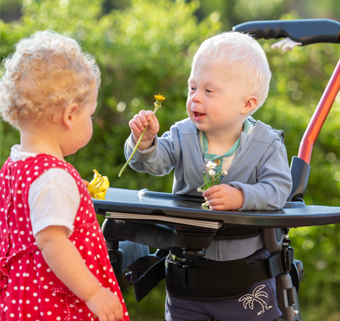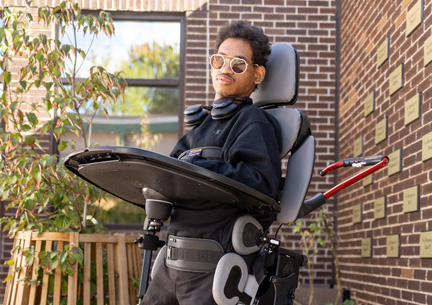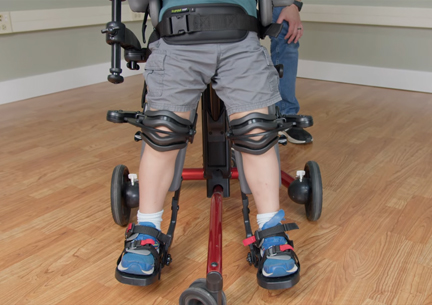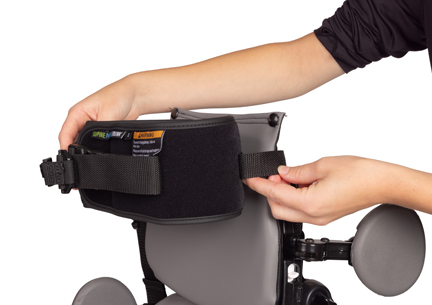Supported Standing: A New Perspective on Physical Activity for Children with CP
| November 2023 Physical inactivity is the fourth risk factor for mortality worldwide.1 In 2010, to counteract the debilitating effects of inactivity and sedentary lifestyles, the World Health Organization (WHO) published guidelines for physical activity across the lifespan. These guidelines were revised in 2020 and for the first time included recommendations on physical activity for people living with chronic conditions or disability.2 For children and adolescents (ages 5-17), the recommendation is for at least 60 minutes of moderate to vigorous, mostly aerobic physical activity every day to prevent long term health risk.1 As well, they recommend strengthening exercises at least three times per week.1 The WHO also recognizes the dose-response relationship between increasing physical activity and improving cardiopulmonary and metabolic health.1 This simply means that exercising more than 60 minutes daily increases the health benefits. The updated guidelines also address the negative health impacts of sedentary behavior, and stress that there are no major risks to people with disabilities engaging in physical activity when it is appropriate to their health status and physical function, and the health benefits generally outweigh the risks.2 The accompanying good practice statements go on to note that for this population, some activity is better than none, and that physical activity will look different from person to person, depending on their age and abilities. This is certainly true for those children with cerebral palsy (CP) because of the different motor, coordination, and balance challenges affecting them.
Physical inactivity is the fourth risk factor for mortality worldwide.1 In 2010, to counteract the debilitating effects of inactivity and sedentary lifestyles, the World Health Organization (WHO) published guidelines for physical activity across the lifespan. These guidelines were revised in 2020 and for the first time included recommendations on physical activity for people living with chronic conditions or disability.2 For children and adolescents (ages 5-17), the recommendation is for at least 60 minutes of moderate to vigorous, mostly aerobic physical activity every day to prevent long term health risk.1 As well, they recommend strengthening exercises at least three times per week.1 The WHO also recognizes the dose-response relationship between increasing physical activity and improving cardiopulmonary and metabolic health.1 This simply means that exercising more than 60 minutes daily increases the health benefits. The updated guidelines also address the negative health impacts of sedentary behavior, and stress that there are no major risks to people with disabilities engaging in physical activity when it is appropriate to their health status and physical function, and the health benefits generally outweigh the risks.2 The accompanying good practice statements go on to note that for this population, some activity is better than none, and that physical activity will look different from person to person, depending on their age and abilities. This is certainly true for those children with cerebral palsy (CP) because of the different motor, coordination, and balance challenges affecting them.
An article by Verschuren and colleagues published in 2016 details exercise recommendations specifically for children and adolescents with CP.3 This research notes that the percentage of time spent in light and moderate to vigorous physical activity decreases while sedentary behavior increases in children demonstrating more severe involvement in the higher Gross Motor Function Classification Scale (GMFCS). For instance, those children in GMFCS Levels IV and V are sedentary more than 95% of the time.3 There is an inverse relationship between severity of disability and time spent upright in standing or walking4. Although Verschuren suggests that children and adolescents with CP should strive to meet recommendations from the WHO, for the most severely involved this may often seem daunting or even completely unattainable.3
Sedentary Behavior and Light Physical Activity
However, another paper by Verschuren provides a new perspective to addressing physical activity in this population. Because of the barriers for children with CP, they suggest shifting the focus away from achieving moderate to high intensity exercise and moving towards decreasing sedentary behavior through the introduction of frequent opportunities for light physical activity.5 Additionally, they define sedentary behavior with three criteria: lacking muscle activity, being positioned in sitting or lying, and expending energy less than or equal to 1.5 metabolic equivalents of a task (MET).5 One metabolic equivalent is the amount of oxygen consumed while resting in a seated position and is used to represent the energy requirements for different physical activities as a multiple of the baseline metabolic rate.6
All three of these factors need to be addressed when working to decrease sedentary behavior – posture, energy expenditure, and muscular inactivity. For example, in individuals with CP, tone or spasticity can increase energy expenditure regardless of positioning.5 In some cases, then, even active sitting is challenging work and not considered a “sedentary behavior.”5 In other instances, for those with CP in the higher GMFCS levels, simply introducing an alternative posture or position can recruit muscular involvement, thereby increasing energy expenditure and reducing sedentary behavior. This can be as simple as providing opportunities for supported standing as demonstrated by another study conducted by Verschuren and colleagues in 2014.
Supported Standing as Physical Activity
In this study, they set out to determine the METs used by children with CP under several conditions including standing.8 The study included 19 children ages 4-20 with spastic CP of all GMFCS levels. They used indirect calorimetry to monitor oxygen consumption and carbon dioxide production and used EMG to measure muscle activity.8 They found that energy expenditure in standing was greater than 1.5 METs (or within the category of light physical activity) for all GMFCS levels.8 Further, muscle activity increased in children who required less support in upright postures and conversely, muscle activity decreased when individuals required more support to maintain an upright posture.8 Interestingly, while fully supported in standing, energy expenditure increased for GMFCS level V even though muscle activation was less.8 Verschuren concluded that standing can be considered “light physical activity” and should be used towards decreasing sedentary behavior for children with cerebral palsy.8
For us as clinicians, we can conclude then that children with cerebral palsy spend the majority of their day in sedentary behaviors and experience significant barriers to engaging in the recommended 60 minutes of moderate to vigorous physical activity as proposed by the World Health Organization. For these children, reducing sedentary behaviors through the introduction of light physical activity and alternative positioning may be a more appropriate path towards healthy lifestyles and habits. Clinicians widely recognize the many benefits of standing frames, including improved hip joint health, increased bone mineral density, management and prevention of contractures, cardiovascular and pulmonary health, increased strength, and improved bowel and bladder function. Now, based on emerging research, we can view the implementation of supported standing interventions or even daily sit-to-stand transfers as a means towards increasing light physical activity and decreasing sedentary behavior.
Sources
- World Health Organization. Global Recommendations on Physical Activity for Health. Geneva, Switzerland: World Health Organization Press, 2010.
- Bull FC, Al-Ansari SS, Biddle S, et al. World Health Organization 2020 guidelines on physical activity and sedentary behaviour. Br J Sports Med. 2020;54(24):1451-1462. doi:10.1136/bjsports-2020-102955. Free Full Text https://bjsm.bmj.com/content/54/24/1451.long
- Verschuren, O., Peterson, M.D., Balemans, A.C.J. and Hurvitz, E.A. (2016), Exercise and physical activity recommendations for people with cerebral palsy. Dev Med Child Neurol, 58: 798-808. https://doi.org/10.1111/dmcn.13053
- Pirpiris M, Graham HK. Uptime in children with cerebral palsy. J Pediatr Orthop. 2004;24(5):521-528. doi:10.1097/00004694-200409000-00012
- Verschuren O, Darrah J, Novak I, Ketelaar M, Wiart L. Health-enhancing physical activity in children with cerebral palsy: more of the same is not enough. Phys Ther. 2014;94(2):297-305. doi:10.2522/ptj.20130214
- Jetté M, Sidney K, Blümchen G. Metabolic equivalents (METS) in exercise testing, exercise prescription, and evaluation of functional capacity. Clin Cardiol. 1990;13(8):555-565. doi:10.1002/clc.4960130809
- Nashner LM, Shumway-Cook A, Marin O. Stance posture control in select groups of children with cerebral palsy: deficits in sensory organization and muscular coordination. Exp Brain Res. 1983;49(3):393-409. doi:10.1007/BF00238781
- Verschuren O, Peterson MD, Leferink S, Darrah J. Muscle activation and energy-requirements for varying postures in children and adolescents with cerebral palsy. J Pediatr. 2014 Nov;165(5):1011-6. doi: 10.1016/j.jpeds.2014.07.027. Epub 2014 Aug 20. PMID: 25151195; PMCID: PMC4440582.







